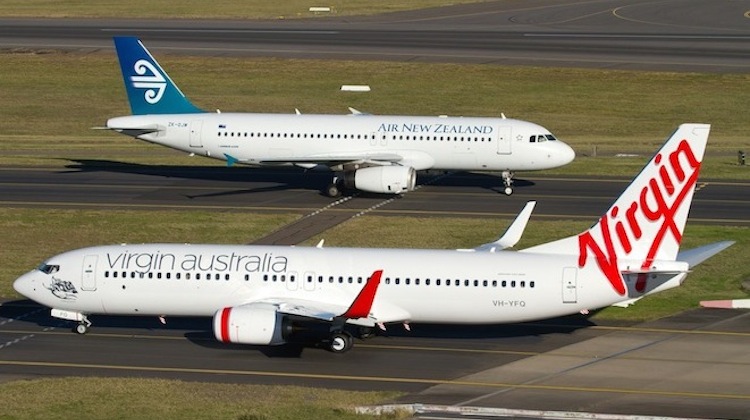
Virgin Australia plans to launch two new trans-Tasman routes and add extra flights into and out of Auckland once its alliance with Air New Zealand ends in October.
The two new routes are Sydney-Wellington – currently served only by Air New Zealand and Qantas – and Melbourne-Queenstown, which has nonstop service from Air New Zealand and Jetstar.
Meanwhile, the airline announced on Monday it would boost its schedule on flights from Auckland to Brisbane (up to three times daily on peak days), Melbourne (twice daily) and Sydney (three times daily on weekdays).
On the minus side, Virgin Australia said it would reduce Christchurch-Melbourne and Brisbane-Wellington nonstop services.
Virgin Australia group executive for airlines Rob Sharp said some flight times would change to better suit the needs of the travelling public.
“We have had a strong presence in New Zealand since 2004, and we look forward to bringing more exciting initiatives to this market very soon,” Sharp said in a statement.
The proposed schedule changes, due to kick on on October 28 2018, are Virgin Australia’s first response to the news on April 4 that it was facing life on the Tasman without a partner after Air New Zealand said it would walk away from an alliance that has been in place since 2010.
The New Zealand carrier has already announced a significant capacity increase once the tie-up is unwound at the end of October, including extra widebody services on key trunk routes such as Auckland-Sydney, Auckland-Brisbane and Auckland-Melbourne.
It is also planning to launch two new routes – Brisbane-Queenstown and Brisbane-Wellington – as well as add extra frequencies from Christchurch to Brisbane and Melbourne and thicken its seasonal schedule on Queenstown-Sydney and Auckland-Gold Coast.
Air New Zealand chief revenue officer Cam Wallace said on April 4 the decision to end the alliance with Virgin Australia was in response to changing market dynamics on the Tasman and a desire from the airline to deliver a more consistent customer experience to its own passengers by using its own aircraft.
The alliance was established seven years ago, and involved a metal-neutral, revenue-sharing joint-venture on on trans-Tasman routes, as well as reciprocal frequent flyer ben
efits.

An analysis of international passenger numbers for January 2018 from the Bureau of Infrastructure, Transport and Regional Economics (BITRE) – the latest month for which figures are available – showed Air New Zealand was the largest operator on trans-Tasman routes, having carried 35 per cent of all traffic in the month, followed by Qantas at 21 per cent.
Virgin Australia was third (16.1 per cent), Jetstar fourth (12.7 per cent) and Emirates fifth (9.6 per cent).
As an alliance, the combined Air New Zealand and Virgin Australia grouping represented 35 per cent of all passengers carried.
Meanwhile, the Emirates/Jetstar/Qantas grouping totalled 44.1 per cent. The three airlines also coordinate their operations on trans-Tasman routes.
However, since January, Emirates has withdrawn its Auckland to Brisbane and Melbourne Airbus A380 daily services.
Aviation thinktank CAPA – Centre for Aviation’s Blue Swan Daily website said in a research note published on April 5 Virgin Australia’s share of trans-Tasman traffic put the airline at a “severe disadvantage in the market”.
“So Virgin has to move,” CAPA said.
And having three major players in the market – Air New Zealand, Emirates/Qantas/Jetstar and Virgin Australia – represented something of a likely boon for travellers.
“Even though it hurts Virgin Australia, it will mean there are now three active competing groups in the market, so consumers won’t miss out,” CAPA said.
“Bottom line though: in the short term, there will be blood. And consumers, tourism bodies and airports will be the beneficiaries.”
All of Virgin Australia’s trans-Tasman flights are currently operated by Boeing 737-800s featuring eight business class seats in 2-2 configuration and 168 economy class seats in a 3-3 configuration for a total of 176.
Its trans-Tasman network consists of nonstop flights from four destinations in Australia – Brisbane, Gold Coast, Melbourne and Sydney – to five destinations in New Zealand – Auckland, Christchurch, Dunedin, Queenstown and Wellington.
The airline also has three Pacific Island routes from New Zealand, year-round Auckland-Rarotonga and Auckland-Nuku’alofa services and a seasonal Christchurch-Rarotonga offering. These are excluded from its soon-to-end alliance with Air New Zealand.
Virgin Australia chief executive John Borghetti said on April 4 the end of its tie-up with Air New Zealand on the trans-Tasman market provided opportunities for the airline group to deploy its low-cost-carrier (LCC) unit Tigerair Australia in the market.
Currently, Tigerair Australia has no international routes, having been forced to end flights to Bali in February 2017 after Indonesian regulators pulled its operating permit to serve the popular tourist destination.
Any re-entry into the international market would allow Virgin Australia to offer both a full-service and LCC option for travellers on the Tasman, while at the same time help improve the utilisation of Tigerair Australia’s Airbus A320s and Boeing 737-800 fleet.
Share of total passengers carried on Australia-New Zealand routes in January 2018
Airline |
Passengers carried |
Percentage share |
|
Air New Zealand |
243,965 |
35.1 per cent |
|
Qantas |
151,593 |
21.8 per cent |
|
Virgin Australia |
111,983 |
16.1 per cent |
|
Jetstar |
87,984 |
12.7 per cent |
|
Emirates |
66,849 |
9.6 per cent |
|
China Airlines |
12,778 |
1.8 per cent |
|
AirAsiaX |
7,432 |
1.1 per cent |
|
LATAM |
7,238 |
1.0 per cent |
|
Singapore Air |
4,077 |
0.6 per cent |
|
Total |
693,899 |
100 per cent |
Source: Bureau of Infrastructure, Transport and Regional Economics (BITRE)
















